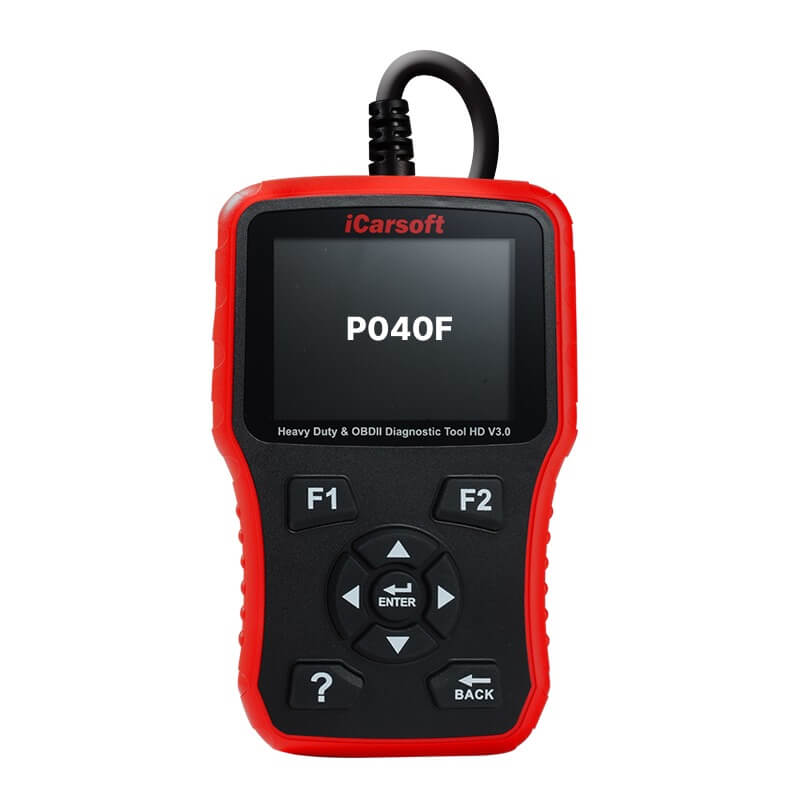P040F – Exhaust Gas Recirculation Temperature Sensor “A” Circuit High
POSTED IN pcodes
Welcome to our article on the P040F code, which refers to an issue with the Exhaust Gas Recirculation (EGR) Temperature Sensor “A” Circuit. In this section, we will provide you with a technical description of the code, discuss its severity, highlight common symptoms, and explore the possible causes. We will also outline the troubleshooting steps and repair options available for resolving this issue.
The EGR Temperature Sensor “A” is responsible for measuring the temperature of the exhaust gas and providing feedback to the engine control module (ECM). This information is crucial for the ECM to make necessary adjustments to the EGR system. When the EGR Temperature Sensor “A” Circuit records a high temperature outside of the normal range, the P040F code is triggered.
This code can manifest in various symptoms that should not be ignored. These include a louder exhaust sound, failing smog or emissions tests, noticeable exhaust smells, engine noises such as knocking or rattling, and the illumination of the service engine soon warning light. If you are experiencing any of these symptoms, it is recommended to address the issue promptly to prevent further damage to your vehicle.
Several factors can contribute to the triggering of the P040F code. Malfunctioning exhaust gas recirculation (EGR) temperature sensors, issues within the EGR system, poor electrical connections, and damaged wiring are common causes. Identifying and addressing these underlying issues is crucial to successfully resolving the P040F code.
When encountering the P040F code, it is important to follow proper troubleshooting steps to diagnose and resolve the issue. These steps may include visually inspecting the EGR temperature sensor and the surrounding EGR system for leaks or damage, cleaning the EGR system to remove any accumulated soot or debris, checking the sensor’s electrical values to ensure they are within the manufacturer’s specified range, and repairing or replacing faulty components as necessary. If in doubt, it is recommended to consult a professional mechanic or refer to a vehicle-specific repair manual for detailed instructions.
Buy tested tuning file for Adblue / EGR / DPF / Adblue off now!
In some cases, professional assistance may be unattainable or the issue may persist even after troubleshooting. In such situations, there is an alternative solution available. This involves the permanent removal of the P040F code by uploading the vehicle’s Engine Control Unit (ECU) file to a designated portal. This process can eliminate the code and improve overall vehicle performance. However, it should only be considered after exhausting all other troubleshooting steps and consulting with a professional technician.
Key Takeaways:
- The P040F code indicates an issue with the Exhaust Gas Recirculation (EGR) Temperature Sensor “A” Circuit.
- Symptoms may include a louder exhaust, smog or emissions test failure, exhaust smells, engine noises, and the illumination of the service engine soon warning light.
- Common causes include malfunctioning sensors, issues with the EGR system, poor connections, and damaged wiring.
- Troubleshooting steps may involve inspecting the sensor and EGR system, cleaning the EGR system, checking electrical values, and repairing or replacing components.
- If necessary, professional assistance or the uploading of the ECU file may be considered.
Symptoms of P040F Code
The P040F code can manifest with various symptoms. These may include a louder exhaust sound, failing smog or emissions tests, noticeable exhaust smells, engine noises such as knocking or rattling, and the illumination of the service engine soon warning light. These symptoms can indicate that there is an issue with the EGR Temperature Sensor “A” Circuit and should be addressed promptly to prevent further damage to the vehicle.

Symptoms of P040F Code
| Symptoms | Description |
|---|---|
| Louder exhaust sound | Experiencing a noticeable increase in exhaust noise |
| Failing smog or emissions tests | Unable to pass required tests for smog or emissions compliance |
| Noticeable exhaust smells | Strong or unusual odors coming from the vehicle’s exhaust |
| Engine noises | Knocking or rattling sounds originating from the engine |
| Service engine soon warning light | Illumination of the warning light on the dashboard |
Common Causes of P040F Code
When it comes to troubleshooting the P040F code, there are several common causes that you should be aware of. By understanding these underlying issues, you can effectively address the code and resolve the problem. The common causes of the P040F code include:
- Malfunctioning Sensors: One of the main culprits behind the P040F code is a malfunctioning exhaust gas recirculation (EGR) temperature sensor. These sensors may have defaults or be out of specification, leading to incorrect readings and triggering the code.
- Issues with EGR System: Problems within the EGR system can also contribute to the P040F code. Leaks or gasket issues in the EGR system can disrupt the proper functioning of the EGR temperature sensor and lead to code activation.
- Poor Connections: Poor electrical connections between the EGR temperature sensor and other components can cause a disruption in the signal transmission. This can result in inaccurate temperature readings and trigger the P040F code.
- Damage to Wiring: Damaged or burnt sensor wires or harness can interfere with the proper functioning of the EGR temperature sensor. This can lead to erratic temperature readings and trigger the code.
To address the P040F code effectively, it is essential to identify and rectify these common causes. By inspecting the sensors and connections, checking for leaks or gasket issues in the EGR system, and repairing any damaged wiring, you can address the underlying problems and clear the P040F code for good.
| Cause | Description |
|---|---|
| Malfunctioning Sensors | Exhaust gas recirculation (EGR) temperature sensors that have defaults or are out of specification. |
| Issues with EGR System | Leaks or gasket issues within the EGR system that disrupt the proper functioning of the EGR temperature sensor. |
| Poor Connections | Poor electrical connections between the EGR temperature sensor and other components, leading to disrupted signal transmission. |
| Damage to Wiring | Damage or burning of the sensor wires or harness, causing erratic temperature readings. |
Troubleshooting Steps for P040F Code
When encountering the P040F code, it is important to follow proper troubleshooting steps to diagnose and resolve the issue. By taking the necessary actions, you can identify and address the underlying causes effectively. Here are the recommended steps:
- Inspect the Sensor and Surrounding EGR System: Start by visually inspecting the EGR temperature sensor and the surrounding EGR system. Look for any signs of leaks or damage that could affect the sensor’s performance. Pay attention to loose connections or disconnected hoses that may interfere with the EGR system.
- Clean the EGR System: Accumulated soot and debris can impact the proper functioning of the EGR system. Clean the system thoroughly to remove any blockages or obstructions. This will help ensure the sensor receives accurate readings and allows for optimal EGR system operation.
- Check Electrical Values: Verify the sensor’s electrical values to ensure they are within the manufacturer’s specified range. Use a multimeter to measure the voltage or resistance of the sensor. Compare the readings with the recommended values to determine if the sensor is functioning correctly.
- Repair or Replace Faulty Components: If any issues are detected during the inspection or testing process, it is crucial to repair or replace the faulty components promptly. This may involve fixing wiring connections, replacing damaged parts, or installing a new EGR temperature sensor if necessary.
Following these troubleshooting steps can greatly assist in resolving the P040F code and restoring the proper functioning of the EGR system. If you are unsure or lack the necessary expertise, it is recommended to consult a professional mechanic or refer to a vehicle-specific repair manual for detailed instructions tailored to your specific make and model.

| Steps | Description |
|---|---|
| 1 | Inspect the Sensor and Surrounding EGR System |
| 2 | Clean the EGR System |
| 3 | Check Electrical Values |
| 4 | Repair or Replace Faulty Components |
Conclusion
If professional assistance is unavailable or if the P040F code issue persists, there is an alternative solution to consider. You can opt for the permanent removal of the code by uploading your vehicle’s Engine Control Unit (ECU) file to a designated portal. This process will eliminate the P040F code and result in improved vehicle performance.
However, it’s crucial to note that this option should only be explored after exhausting all other troubleshooting steps and consulting with a professional technician. The ECU file upload should be approached with caution and expert guidance to ensure its effectiveness and compatibility with your specific vehicle.
By taking the necessary steps and seeking professional assistance when needed, you can address the P040F code and restore your vehicle’s optimal performance.
FAQ
What is the P040F code?
The P040F code refers to an issue with the Exhaust Gas Recirculation (EGR) Temperature Sensor “A” Circuit. This sensor measures the temperature of the exhaust gas and sends feedback to the engine control module (ECM).
What are the symptoms of the P040F code?
Symptoms of the P040F code include a louder exhaust sound, failing smog or emissions tests, noticeable exhaust smells, engine noises like knocking or rattling, and the illumination of the service engine soon warning light.
What are the common causes of the P040F code?
Common causes of the P040F code include malfunctioning EGR temperature sensors, issues within the EGR system, poor electrical connections, and damaged wiring.
What are the troubleshooting steps for the P040F code?
Troubleshooting steps for the P040F code may include visually inspecting the EGR temperature sensor and EGR system for leaks or damage, cleaning the EGR system, checking the sensor’s electrical values, and repairing or replacing faulty components.
Can the P040F code be permanently removed?
Yes, the P040F code can be permanently removed through the upload of the vehicle’s Engine Control Unit (ECU) file to a designated portal. However, this option should only be considered after exhausting all other troubleshooting steps and consulting with a professional technician.


